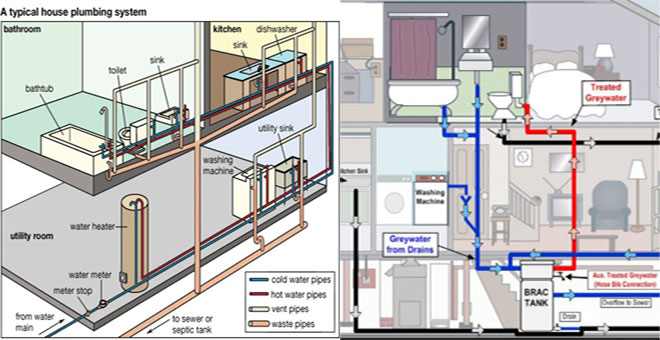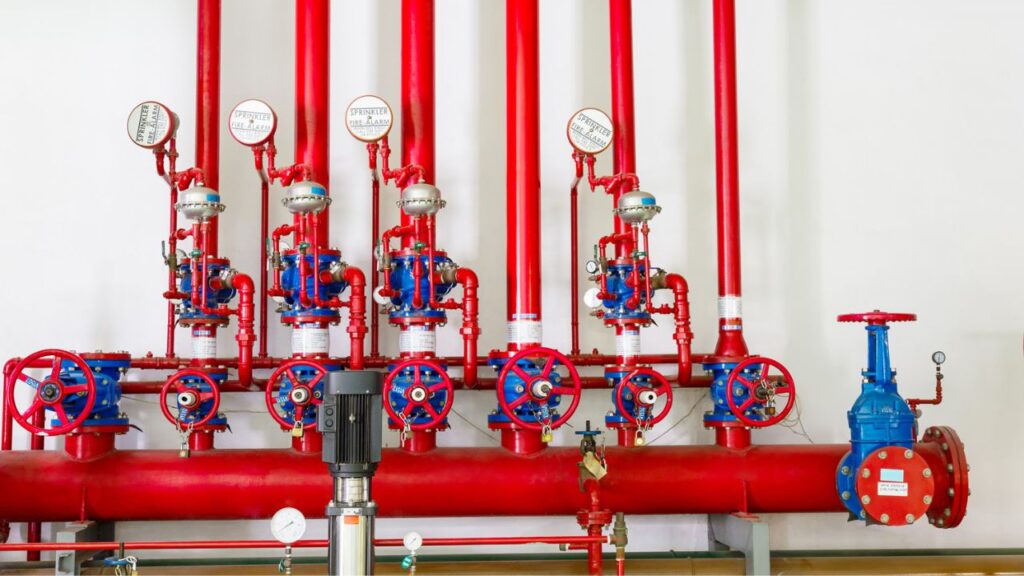The Complete Guide to Your House's Plumbing System Anatomy
The Complete Guide to Your House's Plumbing System Anatomy
Blog Article
The writer is making a number of good annotation on the subject of Anatomy of a House: Understanding the Components as a whole in this post below.

Understanding just how your home's plumbing system works is crucial for each homeowner. From providing clean water for drinking, cooking, and bathing to safely getting rid of wastewater, a well-maintained plumbing system is vital for your family members's wellness and comfort. In this extensive guide, we'll explore the complex network that comprises your home's pipes and offer ideas on upkeep, upgrades, and handling typical problems.
Intro
Your home's pipes system is more than just a network of pipes; it's a complex system that ensures you have access to clean water and efficient wastewater removal. Recognizing its parts and how they collaborate can aid you prevent expensive fixings and ensure whatever runs efficiently.
Standard Components of a Pipes System
Pipes and Tubing
At the heart of your pipes system are the pipelines and tubing that carry water throughout your home. These can be made from different products such as copper, PVC, or PEX, each with its benefits in terms of sturdiness and cost-effectiveness.
Components: Sinks, Toilets, Showers, etc.
Fixtures like sinks, bathrooms, showers, and bath tubs are where water is utilized in your house. Recognizing just how these fixtures link to the plumbing system aids in detecting problems and planning upgrades.
Valves and Shut-off Factors
Valves manage the circulation of water in your plumbing system. Shut-off shutoffs are crucial throughout emergencies or when you require to make repair services, allowing you to isolate parts of the system without interfering with water circulation to the entire home.
Water System
Main Water Line
The major water line attaches your home to the community water system or an exclusive well. It's where water enters your home and is distributed to different fixtures.
Water Meter and Pressure Regulator
The water meter steps your water usage, while a pressure regulator guarantees that water streams at a risk-free pressure throughout your home's plumbing system, stopping damage to pipes and fixtures.
Cold Water vs. Hot Water Lines
Comprehending the difference between cold water lines, which supply water directly from the primary, and hot water lines, which carry heated water from the water heater, helps in repairing and preparing for upgrades.
Drain System
Drain Pipeline and Traps
Drain pipes carry wastewater away from sinks, showers, and commodes to the drain or septic system. Catches protect against sewage system gases from entering your home and likewise trap debris that could create obstructions.
Air flow Pipelines
Air flow pipelines enable air into the water drainage system, stopping suction that might reduce water drainage and trigger traps to empty. Correct air flow is vital for preserving the integrity of your pipes system.
Relevance of Appropriate Drain
Making sure appropriate drainage protects against backups and water damages. Frequently cleaning up drains pipes and preserving traps can protect against expensive repairs and expand the life of your pipes system.
Water Furnace
Kinds Of Water Heaters
Hot water heater can be tankless or standard tank-style. Tankless heaters warm water on demand, while storage tanks store warmed water for instant usage.
Exactly How Water Heaters Connect to the Pipes System
Comprehending just how hot water heater attach to both the cold water supply and hot water circulation lines assists in diagnosing concerns like insufficient warm water or leaks.
Upkeep Tips for Water Heaters
On a regular basis purging your water heater to get rid of debris, checking the temperature level settings, and checking for leakages can extend its life-span and improve power efficiency.
Usual Plumbing Problems
Leakages and Their Causes
Leakages can occur as a result of aging pipelines, loose installations, or high water stress. Addressing leakages promptly stops water damages and mold growth.
Obstructions and Blockages
Obstructions in drains and bathrooms are often triggered by purging non-flushable items or an accumulation of oil and hair. Using drain displays and being mindful of what drops your drains can avoid blockages.
Indicators of Plumbing Issues to Expect
Low water pressure, slow-moving drains pipes, foul odors, or unusually high water expenses are indicators of potential plumbing problems that must be resolved quickly.
Pipes Upkeep Tips
Routine Examinations and Checks
Set up annual plumbing assessments to capture concerns early. Look for indications of leakages, rust, or mineral accumulation in taps and showerheads.
Do It Yourself Maintenance Tasks
Easy tasks like cleansing faucet aerators, looking for commode leakages using color tablet computers, or insulating exposed pipelines in cool climates can avoid major plumbing issues.
When to Call an Expert Plumbing Technician
Know when a pipes problem needs expert experience. Trying intricate fixings without appropriate understanding can cause even more damages and greater fixing prices.
Updating Your Plumbing System
Reasons for Upgrading
Upgrading to water-efficient fixtures or replacing old pipes can improve water quality, reduce water costs, and raise the worth of your home.
Modern Pipes Technologies and Their Advantages
Check out innovations like wise leakage detectors, water-saving bathrooms, and energy-efficient water heaters that can save money and reduce ecological influence.
Expense Factors To Consider and ROI
Determine the in advance prices versus lasting financial savings when thinking about pipes upgrades. Numerous upgrades pay for themselves through reduced energy costs and less repair services.
Environmental Influence and Preservation
Water-Saving Components and Home Appliances
Setting up low-flow faucets, showerheads, and bathrooms can considerably lower water use without compromising performance.
Tips for Reducing Water Use
Basic practices like repairing leaks without delay, taking shorter showers, and running full lots of washing and dishes can conserve water and lower your utility costs.
Eco-Friendly Plumbing Options
Consider lasting pipes materials like bamboo for flooring, which is durable and environmentally friendly, or recycled glass for kitchen counters.
Emergency situation Preparedness
Actions to Take During a Pipes Emergency
Know where your shut-off valves lie and exactly how to shut off the supply of water in case of a ruptured pipeline or major leakage.
Significance of Having Emergency Calls Useful
Maintain get in touch with information for regional plumbers or emergency solutions easily available for fast action during a pipes crisis.
Do It Yourself Emergency Fixes (When Applicable).
Momentary fixes like using air duct tape to patch a dripping pipeline or placing a pail under a dripping faucet can decrease damage till a professional plumbing professional arrives.
Verdict.
Understanding the makeup of your home's plumbing system equips you to maintain it successfully, saving money and time on repairs. By complying with normal maintenance routines and remaining informed regarding modern-day plumbing innovations, you can guarantee your plumbing system runs successfully for many years ahead.
Understanding Your Home Plumbing System: A Comprehensive Guide
Plumbing System: The Lifeline of Your Home
At its core, the plumbing system is designed to perform two primary functions: bring fresh water into your home and remove wastewater. The system is a network of pipes, fixtures, and other components that transport water and sewage. Residential plumbing systems include potable water supply lines, drain-waste-vent (DWV) systems, and various plumbing fixtures that make water use in daily tasks possible.
Key Components:
Water Supply: This part of your plumbing system brings municipal water into your home, passing through the main water supply line. It s responsible for supplying all water needs, from drinking to bathing.
Drainage System: It carries waste and water away from your home to the sewer or septic system. This system includes all the piping within your home that leads to external sewage or septic systems.
Vent System: An essential yet often overlooked component, the vent system allows sewer gases to escape and lets air into the drainpipes, ensuring water and waste move correctly through the system.
Fixture: More Than Just Taps and Toilets
Plumbing fixtures are the most interactive parts of the plumbing system, including faucets, showers, toilets, and sinks. Each fixture is connected to the plumbing system and plays a role in either the delivery of freshwater or the disposal of waste and wastewater.
Types of Fixtures:
Faucets and Sinks: Used for washing hands, dishes, and other daily water needs.
Toilets: Dispose of human waste through the sewage system.
Bathtubs and Showers: Provide bathing facilities, requiring both hot and cold water supply.
Water Supply: The Source of Life
The water supply system is a critical component, ensuring that potable water is available throughout your home for various uses, including drinking, cooking, and cleaning. This system consists of pipes that distribute water to different parts of the house, controlled by valves to regulate the water flow.
Types of Plumbing: Materials and Methods
Various types of plumbing systems and materials are used in residential settings, each with its advantages and applications. From copper and PVC pipes for water supply to cast iron and ABS for drainage, the choice of materials can impact the longevity and efficiency of your plumbing system.
https://intownplumbingtx.com/articles/home-plumbing-system-guide/

Understanding Your Home Plumbing System: A Comprehensive Guide
Plumbing System: The Lifeline of Your Home
At its core, the plumbing system is designed to perform two primary functions: bring fresh water into your home and remove wastewater. The system is a network of pipes, fixtures, and other components that transport water and sewage. Residential plumbing systems include potable water supply lines, drain-waste-vent (DWV) systems, and various plumbing fixtures that make water use in daily tasks possible.
Key Components:
Water Supply: This part of your plumbing system brings municipal water into your home, passing through the main water supply line. It s responsible for supplying all water needs, from drinking to bathing.
Drainage System: It carries waste and water away from your home to the sewer or septic system. This system includes all the piping within your home that leads to external sewage or septic systems.
Vent System: An essential yet often overlooked component, the vent system allows sewer gases to escape and lets air into the drainpipes, ensuring water and waste move correctly through the system.
Fixture: More Than Just Taps and Toilets
Plumbing fixtures are the most interactive parts of the plumbing system, including faucets, showers, toilets, and sinks. Each fixture is connected to the plumbing system and plays a role in either the delivery of freshwater or the disposal of waste and wastewater.
Types of Fixtures:
Water Supply: The Source of Life
The water supply system is a critical component, ensuring that potable water is available throughout your home for various uses, including drinking, cooking, and cleaning. This system consists of pipes that distribute water to different parts of the house, controlled by valves to regulate the water flow.
Types of Plumbing: Materials and Methods
Various types of plumbing systems and materials are used in residential settings, each with its advantages and applications. From copper and PVC pipes for water supply to cast iron and ABS for drainage, the choice of materials can impact the longevity and efficiency of your plumbing system.
https://intownplumbingtx.com/articles/home-plumbing-system-guide/
Do you enjoy reading up on Plumbing Installation 101: All You Need to Know? Write feedback down below. We'd be delighted to listen to your suggestions about this piece. We are looking forward that you come back again soon. Do you know somebody else who is excited by Understanding Your Home's Plumbing Anatomy? Why not share it. Thank you so much for taking the time to read it.
Order Repair Report this page